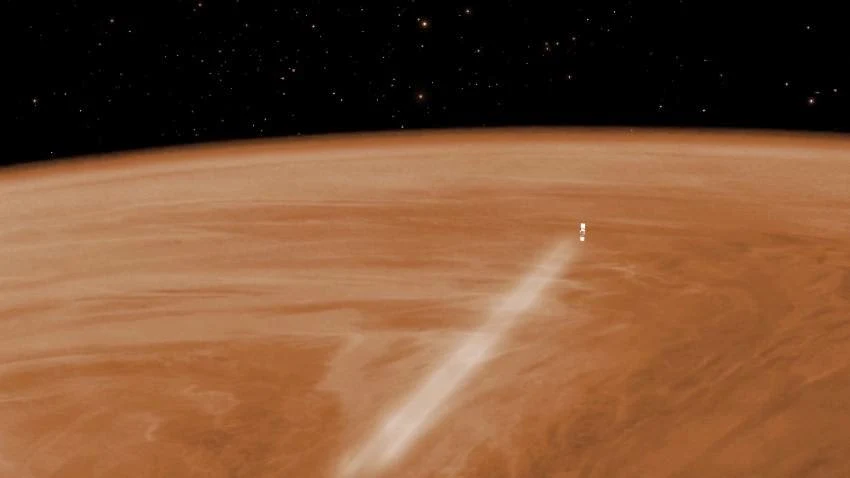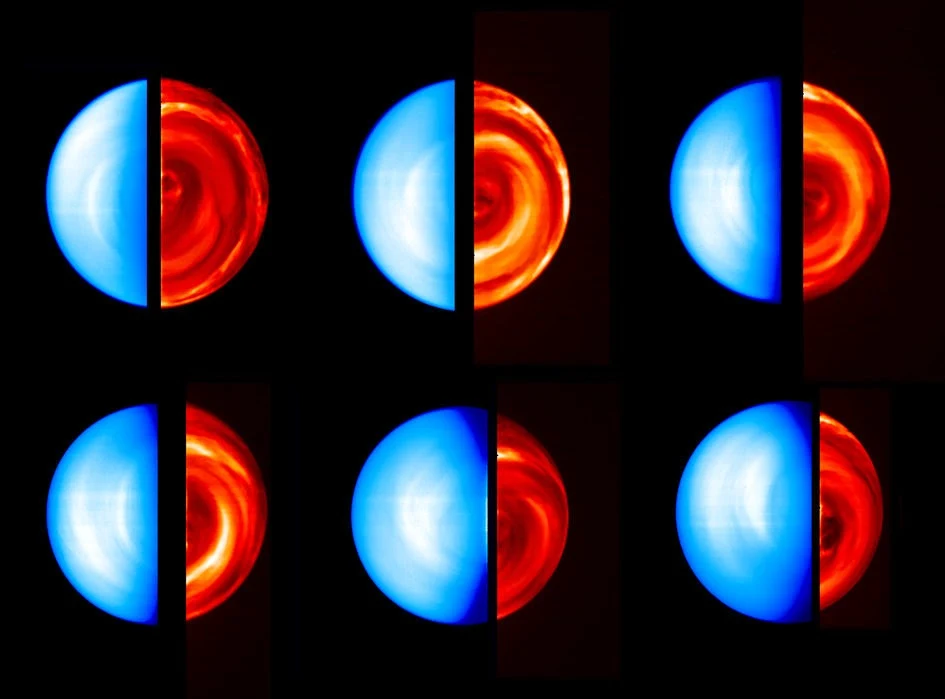Δορυφόρος
αυτοκτονεί εισπνέοντας τη δηλητηριώδη ατμόσφαιρα της Αφροδίτης. Visualisation
of Venus Express during the aerobraking manoeuvre, which will see the
spacecraft orbiting Venus at an altitude of around 130 km from 18 June to 11
July. In the month before, the altitude will gradually be reduced from around
200 km to 130 km. If the spacecraft survives and fuel permits, the elevation of
the orbit will be raised back up to approximately 450 km, allowing operations
to continue for a further few months. Eventually, however, the spacecraft will
plunge back into the atmosphere and the mission will end. Credit: ESA–C. Carreau
Έπειτα
από οκτώ χρόνια σε τροχιά γύρω από την Αφροδίτη, η ευρωπαϊκή αποστολή Venus Express ετοιμάζεται για το δραματικό τέλος: τον
Ιούνιο κατέβει να θα πάρει τις πρώτες εισπνοές στην τοξική ατμόσφαιρα του
πλανήτη, και λίγους μήνες αργότερα θα αυτοκτονήσει με βουτιά στα σύννεφα από
βιτριόλι.
Τα
δύο πρόσωπα της Αφροδίτης: το νότιο (πάνω) και το βόρειο ημισφαίριο. Το κόκκινο
αντιστοιχεί σε υπέρυθρες λήψεις της πλευράς που έχει νύχτα, το μπλε σε
υπεριώδης λήψεις στην πλευρά που έχει μέρα. This sequence of images
was taken by the Ultraviolet/Visible/Near-Infrared spectrometer (VIRTIS) on board
ESA’s Venus Express spacecraft between 12 and 19 April 2006, during the first orbit
(capture orbit) around the planet. The images were obtained at six different
time slots and different distances from the planet (top left: 12 April, from
210 000 kilometres; top centre: 13 April, from 280 000 kilometres; top right:
14 April, from 315 000 kilometres; bottom left:16 April, from 315 000
kilometres; bottom centre: 17 April, from 270 000 kilometres; bottom right: 19
April, from 190 000 kilometres), while the spacecraft moved along a long
ellipse around Venus. Each image is the composite of the day side of Venus
(left, in blue, taken in visible light at 380 nanometres) and the night side
(right, in a red colour scheme, taken in infrared light at 1.7 microns). The
visible part shows solar radiation reflected by the atmosphere. The infrared
part shows complex cloud structures, revealed by the thermal radiation coming
up from different atmospheric depths. Venus Express can resolve these
structures by use (for the first time from orbit) of the so so-called ‘infrared
windows’ present in the atmosphere of Venus. In fact, if observed at certain
wavelengths, it is possible to detect thermal radiation leaking from the
deepest atmospheric layers, revealing what lies beneath the dense cloud curtain
situated at about 60 kilometres altitude. In the colour scheme of the presented
infrared images, the brighter the colour, the more radiation comes up from the
lower layers. Credits: ESA/VIRTIS/INAF-IASF/Obs. de Paris-LESIA
Ο
δορυφόρος της ευρωπαϊκής διαστημικής υπηρεσίας ESA έχει αρχίσει να εξαντλεί τα καύσιμα με τα
οποία διατηρείται σε μια έντονα ελλειπτική τροχιά, της οποίας το ύψος
αυξομειώνεται από τα 66.000 χιλιόμετρα πάνω από το νότιο πόλο μέχρι τα 250
μόλις χιλιόμετρα πάνω από το βόρειο πόλο, κοντά στην κορυφή της ατμόσφαιρας.
Από
τις 18 Ιουνίου έως τις 11 Ιουλίου, το σκάφος θα πραγματοποιήσει έναν ελιγμό
«πειραματικής αεροπέδησης», κατά τον οποίο θα κατέβει σε ύψος κάτω από 165
χιλιόμετρα. Θα εισέλθει έτσι στα ανώτερα στρώματα της ατμόσφαιρας και θα
πραγματοποιεί μετρήσεις καθώς σταδιακά επιβραδύνεται.
Οι
μηχανικοί της αποστολής αναγνωρίζουν ότι η ριψοκίνδυνη μανούβρα μπορεί να
καταναλώσει όλα τα εναπομείναντα καύσιμα ή ακόμα και να καταστρέψει το σκάφος.
Θα προσφέρει ωστόσο πολύτιμα δεδομένα για την αξιοποίηση της αεροπέδησης ως
τεχνικής για είσοδο σε τροχιά όταν ένα σκάφος πλησιάζει υπερβολικά γρήγορα τον
πλανήτη στόχο.
Animation της διαδικασίας «αεροπέδησης», κατά την
οποία το σκάφος θα ξύσει την ατμόσφαιρα. Visualisation of
the Venus Express aerobraking manoeuvre, which will see the spacecraft orbiting
Venus at an altitude of around 130 km from 18 June to 11 July. In the month
before, the altitude will gradually be reduced from around 200 km to 130 km. If
the spacecraft survives and fuel permits, the elevation of the orbit will be
raised back up to approximately 450 km, allowing operations to continue for a
further few months. Eventually, however, the spacecraft will plunge back into
the atmosphere and the mission will end. Credit:
ESA–C.Carreau
Αν
όλα πάνε καλά, το Venus
Εxpress θα συνεχίσει να
λειτουργεί για λίγους ακόμα μήνες, κινούμενο σε μια διαρκώς φθίνουσα τροχιά. Τελικά,
πιθανότατα μέχρι τα τέλη του έτους, ο δορυφόρος θα πραγματοποιήσει βουτιά
αυτοκτονίας στην πυκνή ατμόσφαιρα του πλανήτη.
Αφροδίτη:
ο παράδεισος που έγινε κόλαση
Artist’s impression
of an active volcano on Venus. Results from a long-term study of Venus find
evidence of a clear injection of sulphur dioxide into its upper atmosphere. One
possible interpretation is that volcanic activity increased the sulphur dioxide
component of the upper atmosphere, although an alternative is that a change in
atmospheric circulation dredged up the gas. Credit: ESA/AOES
Λόγω
ενός ακραίου φαινομένου του θερμοκηπίου, η επιφάνεια της Αφροδίτης βράζει
σήμερα στους 450 βαθμούς Κελσίου, θερμοκρασία αρκετή για να λιώσει μολύβι, ενώ
τα πυκνά, αδιαπέραστα σύννεφα θειικού οξέος κυριολεκτικά βρέχουν βιτριόλι.
Το
Venus Express, όμως, αποκάλυψε ότι ο γειτονικός πλανήτης
διέθετε κάποτε τεκτονικές πλάκες και ήταν γεωλογικά ενεργός με ενδείξεις
ηφαιστειακής δραστηριότητας που πηγαίνουν πίσω το πολύ 2,5 εκατ. χρόνια, και
ίσως συνεχίζεται έως σήμερα.
Η
νεαρή Αφροδίτη δεν αποκλείεται να διέθετε ακόμα και ωκεανούς, οι οποίοι
αργότερα χάθηκε. Όπως διαπίστωσε ο δορυφόρος, ακόμα και σήμερα μόρια νερού
διασπώνται ψηλά στην ατμόσφαιρα και χάνονται στο Διάστημα.
Το
νότιο ημισφαίριο της Ααφροδίτης. This global view of the southern
hemisphere of Venus is a mosaic of images obtained by the Visible and Infrared
Thermal Imaging Spectrometer (VIRTIS) on board ESA’s Venus Express on 16 May
2006. The night-side hemisphere (in red at the top) is made of infrared images
taken at 1.74 micrometres, showing the lower layers of the cloud deck
surrounding the planet at about 45-km altitude. The day-side hemisphere (in
blue at the bottom) is made of ultraviolet images taken at 480 nanometres. It
shows the cloud top layer at about 65-km altitude. The red part of the central
panel was taken at 3.8 micrometres, and shows the double vortex at the south
pole, at an altitude of about 60 km, surrounded by a collar of ‘cold’ air.
Credit: ESA/VIRTIS-VenusX IASF-INAF, Observatoire de Paris (R.Hueso, Univ.
Bilbao)
Ακόμα,
οι κάμερες του σκάφους κατέγραψαν μια γιγάντια δίνη στα σύννεφα περίπου 70 χλμ
πάνω από το νότιο πόλο, η οποία παρουσιάζει ομοιότητες με τους κυκλώνες της
Γης. Ο δορυφόρος κατέγραψε επίσης την ηλεκτρομαγνητική υπογραφή κεραυνών που
πηγάζουν από τα παχιά σύννεφα θειικού οξέος.
Δύο
άλλα μη αναμενόμενα νέα στοιχεία είναι ότι η ατμόσφαιρα της Αφροδίτης, η οποία
περιστρέφεται με μεγάλη ταχύτητα γύρω από τον πλανήτη, μαστίζεται από ανέμους
των οποίων η μέση ταχύτητα αυξήθηκε σε έξι χρόνια από τα 300 στα 400 χιλιόμετρα
ανά ώρα.
Τέλος,
από την εποχή που επισκέφθηκε τον πλανήτη η αποστολή Magellan πριν από 20 χρόνια, η διάρκεια της ημέρας
στην Αφροδίτη μειώθηκε μυστηριωδώς κατά 6,5 λεπτά, πιθανώς λόγω αλληλεπίδραση
με την παράξενη περιστρεφόμενη ατμόσφαιρα.

























-19.JPG)











